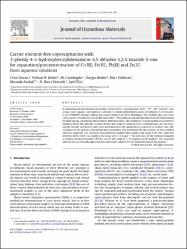Carrier element-free coprecipitation with 3-phenly-4-o-hydroxybenzylidenamino-4,5-dihydro-1,2,4-triazole-5-one for separation/preconcentration of Cr(III), Fe(III), Pb(II) and Zn(II) from aqueous solutions
Access
info:eu-repo/semantics/openAccessDate
2009Access
info:eu-repo/semantics/openAccessMetadata
Show full item recordCitation
C. Duran, V.N. Bulut, A. Gundogdu, D. Ozdes, N. Yildirim, M. Soylak, H.B. Senturk, L. Elci, “Carrier element-free coprecipitation with 3-phenly-4-o-hydroxybenzylidenamino-4,5-dihydro-1,2,4-triazole-5-one for separation/preconcentration of Cr(III), Fe(III), Pb(II) and Zn(II) from aqueous solutions”, Journal of Hazardous Materials, 167 (1-3), 294-299 (2009).Abstract
A separation/preconcentration procedure, based on the coprecipitation of Cr3+, Fe3+, Pb2+ and Zn2+ ions using a new organic coprecipitant, 3-phenly-4-o-hydroxybenzylidenamino-4,5-dihydro-1,2,4-triazole-5-one (POHBAT) without adding any carrier element has been developed. The method, thus, has been called carrier element-free coprecipitation (CEFC). The resultant concentrated elements were determined by flame atomic absorption spectrometric determinations. The influences of some analytical parameters including pH of the solution, amount of the coprecipitant, standing time, centrifugation rate and time, sample volume and diverse ions were investigated on the quantitative recoveries of analyte ions. The validation of the present preconcentration procedure was performed by the analysis of two certified reference materials. The recoveries of understudy analytes were found in the range of 93-98%, while the detection limits were calculated in the range of 0.3-2.0 µg L-1. The precision of the method evaluated as relative standard deviation (R.S.D.), was in the range of 3-7% depend on the analytes. The proposed method was successfully applied to environmental samples for the determination of the analytes.


















